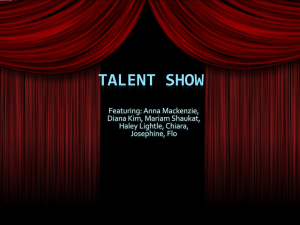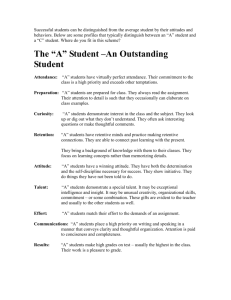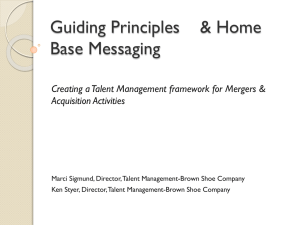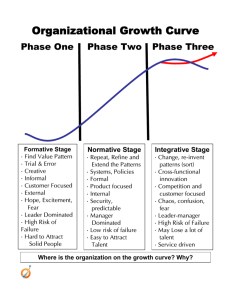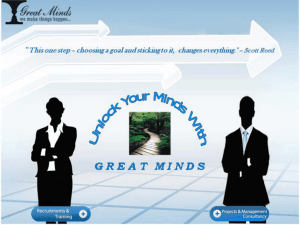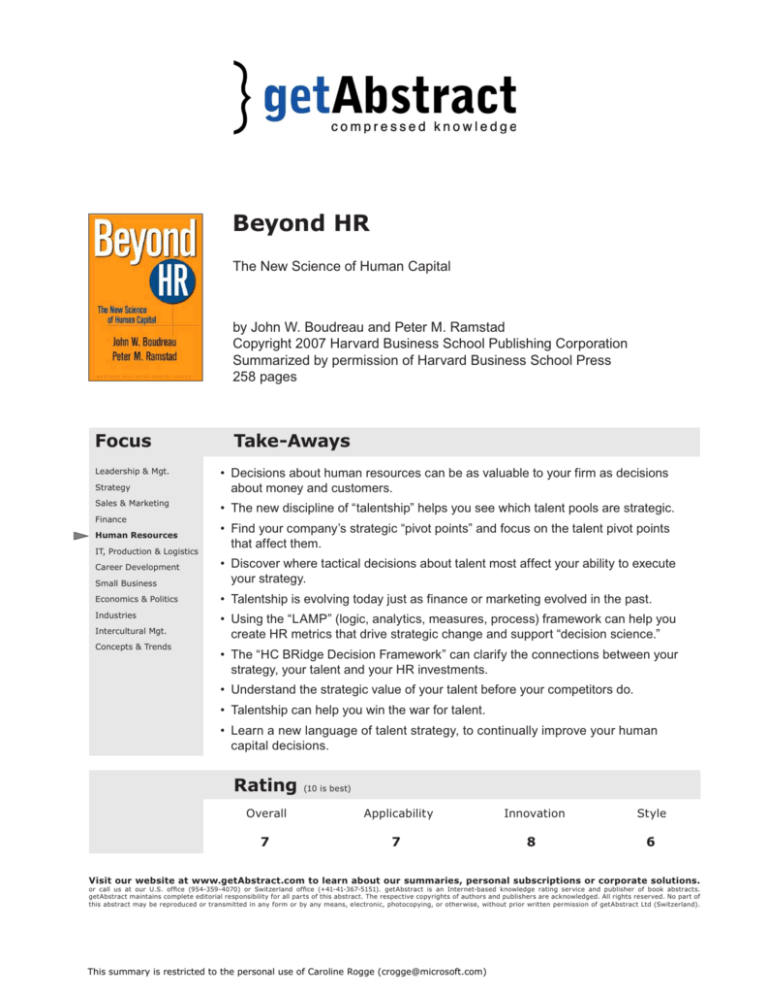
Beyond HR
The New Science of Human Capital
by John W. Boudreau and Peter M. Ramstad
Copyright 2007 Harvard Business School Publishing Corporation
Summarized by permission of Harvard Business School Press
258 pages
Focus
Leadership & Mgt.
Strategy
Sales & Marketing
Finance
Human Resources
IT, Production & Logistics
Take-Aways
• Decisions about human resources can be as valuable to your firm as decisions
about money and customers.
• The new discipline of “talentship” helps you see which talent pools are strategic.
• Find your company’s strategic “pivot points” and focus on the talent pivot points
that affect them.
Small Business
• Discover where tactical decisions about talent most affect your ability to execute
your strategy.
Economics & Politics
• Talentship is evolving today just as finance or marketing evolved in the past.
Industries
• Using the “LAMP” (logic, analytics, measures, process) framework can help you
create HR metrics that drive strategic change and support “decision science.”
Career Development
Intercultural Mgt.
Concepts & Trends
• The “HC BRidge Decision Framework” can clarify the connections between your
strategy, your talent and your HR investments.
• Understand the strategic value of your talent before your competitors do.
• Talentship can help you win the war for talent.
• Learn a new language of talent strategy, to continually improve your human
capital decisions.
Rating
(10 is best)
Overall
Applicability
Innovation
Style
7
7
8
6
Visit our website at www.getAbstract.com to learn about our summaries, personal subscriptions or corporate solutions.
or call us at our U.S. office (954-359-4070) or Switzerland office (+41-41-367-5151). getAbstract is an Internet-based knowledge rating service and publisher of book abstracts.
getAbstract maintains complete editorial responsibility for all parts of this abstract. The respective copyrights of authors and publishers are acknowledged. All rights reserved. No part of
this abstract may be reproduced or transmitted in any form or by any means, electronic, photocopying, or otherwise, without prior written permission of getAbstract Ltd (Switzerland).
This summary is restricted to the personal use of Caroline Rogge (crogge@microsoft.com)
Relevance
What You Will Learn
In this Abstract, you will learn: 1) Why HR needs to be based on a “decision science”; 2)
How implementing the decision science of “talentship” will help your organization become
more competitive; 3) Why your company’s “pivot points” are essential; and 4) How using the
“LAMP” framework can help you create HR measures that truly drive strategic change.
Recommendation
John W. Boudreau and Peter M. Ramstad say that companies need to transform their
human resource (HR) function into a strategic resource, and compete for talent using
HR as a “decision science.” The tactical skill they call “talentship” is a management
approach that enables firms to understand the strategic nature of their employee base
and to build value through the way they handle people. Using their human capital
decision-making framework (“HC BRidge”) and examples from companies as diverse
as Disney, McDonalds, Boeing and Williams-Sonoma, they explain that leaders inside
and outside of HR must be aware of their competitive talent “pivot points.” Though on
the dry side, this targeted book will give you a more energetic vision of what HR can
become. getAbstract recommends it to HR professionals who want a practical, actionable
framework for implementing talent-oriented ideas.
Abstract
“We have
coined the term
‘talentship’ to
describe the new
decision science
and to reflect
the notion of
stewardship of
employee talent
resources.”
“There are at least
three markets vital
to organizational
success: the
financial market,
the customer
market and the
talent market.”
Talent and Expertise
Organizations relocate to different geographic areas for many reasons, usually financial.
The company announces the move, but the people who possess its strategic talent and
expertise may decide they don’t want to go. Instead, they find new jobs. Viewing people
as fungible cogs that you can replace easily is usually a bad idea, but treating your firm’s
most talented employees this way is worse. Their talent is in demand for a reason: you
and your rivals understand its value and will compete for it. They understand that both
the company and the job are replaceable.
The talent and expertise of a company’s employees have become a strategic resource.
The talent within a firm has a profound impact on its ability to compete. The first step
in developing this resource is to clarify your strategy, understand its pivotal talent
implications, and consider the information and resources needed to support those
decisions. The evolved process of competing for talented people is called “talentship.”
Operating parallel to the marketing and finance disciplines, the “decision science” of
talentship uncovers the connection between traditional HR activities, such as recruiting,
hiring, training, developing and retaining employees, and the firm’s strategic goals.
The business methods, reports, ratios and tools used for making decisions in accounting
and finance have developed and matured over decades. Talentship is just emerging, but
experts have already identified some key concepts that anchor it and reveal a direction
for future development. One fundamental idea is that the talent is not uniform across
the firm. Just as marketers determine which customer segments are more pivotal than
others, decision makers need to identify which talent-related positions provide the
biggest return on investment.
Beyond HR
© Copyright 2007 getAbstract
2 of 5
“How concerned
would you be if
your competitor
had a copy of your
HR strategy? Too
often, the answer
we get is ‘Not
very concerned,
because ours
probably looks
a lot like theirs
anyway’.”
“Research shows
that if managers
don’t perceive HR
issues as strategic
and analytical in
the first place,
they may simply
ignore numerical
and analytical
information
about HR.”
“Like finance
and marketing,
talentship must
become an
integral element of
the mental models
that HR and
business leaders
use to advance
the organization’s
competitive
success.”
“Leaders have
told us that a
turnover cost
analysis was their
first realization
that talent and
organization
decisions had
tangible effects
on the economic
and accounting
processes.”
Merely identifying talent pools or jobs, and counting how many bodies you need to fill
open positions is a limited way to carry out personnel planning. The company must
understand, at all levels, where varying performance will most affect its results. Such
“pivot points” should receive the most attention. Ask yourself where an improvement in
the quality of talent and organization would make the biggest difference. This question
focuses attention on why you hire people in the first place: the strategic success of the
firm. The process and the resources do not need to be the same for every job, but should
reflect the critical effect that particular job has on the firm’s business.
Consider what a theme park needs in the way of talent. Although the Disney characters are
important to the customer experience at Disneyland, the range between the worst Mickey
Mouse and the best is constrained because of the way the job is structured. However, the
job of sweeper not only has an impact on the cleanliness of the park, but also on the
direct customer experience. Besides keeping the park clean, sweepers also have many
unique opportunities to help customers; they are “customer ambassadors.” Disney puts
extra resources into hiring and training sweepers, and that policy pays dividends.
Human Capital Strategy
The “Human Capital BRidge” is a decision-making framework for connecting your HR
investments to your unique strategies.. This approach focuses on the three anchor points
– impact, efficacy and efficiency – that inform your investment in talent, programs and
practices. For maximum competitive advantage, use these three anchor points to help
you align pivot points in seven areas:
1.
2.
3.
4.
5.
6.
7.
“Sustainable strategic success.”
“Resources and processes.”
“Organization and talent.”
“Interactions and actions.”
“Culture and capacity.”
“Policies and practices.”
“Investments.”
This structure raises many diagnostic questions, such as determining how to make your
competitive advantages difficult to duplicate. Where would hiring more employees have
a greater impact than hiring better employees? What challenges do talented people face
in key roles? How can management respond to those issues in a way that fits its priorities?
How will your practices distinguish you in the talent market? Most organizations can
create a better alignment between talent and pivot points. The key is to make this match
with greater rigor and logic.
To understand the strategic implications of talent, ask these questions: Do your competitors’
assumptions about the future of the industry differ from yours? What can you do to
ensure that your strategic assumptions are correct? What assumptions does your strategy
depend on? What would happen to your strategy if these assumptions changed? To keep
and hold a position over a rival company, a firm must be able to preserve an established
difference. A generic model cannot provide the required differentiation.
A company must protect its sustained differentiators and seek to neutralize its competitors’.
No company has infinite resources, so you must understand both what your firm’s
resources are and how they can make your competitive advantage hard to duplicate.
Management should also think about the assets, expertise or capacities the company has
Beyond HR
© Copyright 2007 getAbstract
3 of 5
“A company
can outperform
rivals only if it
can establish a
difference that it
can preserve.”
[ – Michael Porter]
“As organizations
get better
at applying
talentship, we
will see far more
specificity, logic
and integration
between how
they analyze and
respond to talent
and questions of
supply, demand
and strategy.”
“Qualities for
which WilliamsSonoma is
recognized
– image, products
and sophisticated
retail skills
– were significant
attractors for a
certain subgroup
of the technical
population.”
“GE and Berkshire
Hathaway are
successful
because they
understand how
the organization
and quality of
leadership and
top management
talent contribute
to their unique
strategic value.”
that its competitors would most like to have themselves. If your competitors really want
that capacity or asset, how would they emulate it? How could they undermine its value?
Could they offer your customers an effective substitute?
Make Strategic Advantages Work
Once you understand these strategic points, it becomes easier to connect them to structures
and roles in the firm. To use talentship to obtain a strategic advantage, determine how
your talent pools link to these structures and roles. Align the different management
systems in the firm (this will require making organizational boundaries more effective),
and determine where adding more staff or higher caliber people will do the most good.
The organization’s design can enhance the value chain. However, the value chain can slip
away from the firm. IBM outsourced the first PC processors to Intel and the operating
system to Microsoft. It is no coincidence that IBM does not make PCs any more.
Identify the key strategic resources. Make sure that the organization supports them
efficiently, so they generate the maximum possible value. Part of this value-supporting
process is recognizing the constraints on talent, and either eliminating or creatively
managing those constraints before they become potential crisis points. If a position is
sensitive to a difference in performance, the natural response is to look for a higher
quality person to fill that slot. Another approach is to restructure the position so that the
differences between the caliber of people matter much less because they will all perform
the job in the same way. This standardization maintains quality; it removes the variation
from a role to reduce the risk. McDonalds now takes drive-through orders by using
shared, remote order takers, thus making the job less pivotal.
In contrast, order taking is a key part of the “Starbucks Experience.” Each barista is
carefully selected and trained exhaustively, because the job calls for providing each
customer with a special event. Baristas must learn the names of regular patrons, help
customers connect to Starbucks’ Wi-fi network and master the store’s complex array
of drinks. The Starbucks network of trust begins with customers trusting that their
experience will be exceptional. Starbucks trusts its employees to deliver that experience,
and employees trust Starbucks because of the way the company’s culture reinforces and
proves its dependability and trustworthiness.
Williams-Sonoma is an interesting example of integrated actions, capacities and culture.
It markets high-end kitchenware and runs a successful mail order catalog. During the
Internet boom, it decided to extend its catalog to a Web site. However, hiring talent
presented a problem in its hometown, San Francisco, where competition for IT staff and
Web programmers is steep. Williams-Sonoma could not offer exotic salary packages or
explosive growth to tempt outside talent. However, it had a strong brand and a database
of 19 million customers, 75% of whom said they used the Internet. Management decided
that it didn’t need to employ generic programmers. Rather, it needed technical people
who could work with the catalog’s designers and copywriters, and translate their vision
into Web pages. The company’s crucial pivot point was the opportunity to create a Web
site that was “culturally and strategically integrated” with its brand.
Too often, companies make policy decisions, especially HR policies, based on a fad
or on the policies of another company. In 2001, Jack Welch, former CEO of GE, said
that only 20% of its employees should receive top reviews, 70% should get mid-level
reviews and 10% should be at the bottom. Companies of all sizes grabbed on to this
Beyond HR
© Copyright 2007 getAbstract
4 of 5
tenet simply because Welch said it. The 20-70-10 policy worked for GE because its entire
culture supported it. Attempts to apply it to companies without compatible cultures
were doomed to fail.
“A decision is an
invitation to think
differently.”
Using Talent Measurement
Since business is about money, a company’s ability to operate efficiently and control
its costs is obviously important. But do not mistake low cost for impact. The question
should be how efficiently the company is spending money while still meeting its strategic
objectives. The problem is that many efficiency metrics are based on accounting systems
that measure only the costs of HR practices. These metrics do not capture the costs of
opportunity and talent value that are lost when useful HR programs are cut just to save
money. A firm can compete better if its leaders truly understand its strategic objectives
and pivot points, and make decisions that support them.
The complaint that HR is soft because companies can’t measure its strategic impact is
simply untrue. The opposite is more likely: A quick Web search on “HR measurement”
will return tens of thousands of results. The problem is that these measures are not
connected to – and do not drive – strategic decisions. Few accounting measures focus on
telling decision makers how well the accounting department is running its processes and
services, yet most HR measures focus only on HR activities, not outcomes.
To supplement the usual accounting measures, use a talent measurement system that
enhances your strategic decisions. The four-part “LAMP” (logic, analytics, measures,
process) framework can help HR extend toward becoming a decision science that provides
hard information about talent, data that firms can use to support key decisions. It assesses:
•
•
•
•
“Capability,
opportunity,
motivation and
culture must work
together and be
in balance. If
any one of them
goes to zero, then
human capacity
will go to zero.”
“The right logic” – Competitive advantage and pivot points.
“The right analytics” – Information, questions and statistics.
“The right measures” – Available and reliable data.
“The right process” – How measures will be used.
Using this evaluation, particularly in the context of aligning pivot points, the human
resources department can provide key decision-making data. Choose the assessments
that matter to your company. If employee turnover is important, calculate and report it
in a way that provides relevant information. Losing a few employees in a nonstrategic
area or having poor performers leave is far less serious than the departure of critical
engineers or top salespeople. Apply analytics to derive results that matter to the success
of your business.
Making perfect decisions is not the goal of these tools any more than marketing, finance or
accounting tools lead to perfect decisions. The goal is to improve strategic decision making
and be able to make crucial decisions faster than the competition. Talentship can be an agent
of sustainable change. It doesn’t have to wait for new strategies to emerge. Companies can
use it now to improve existing strategies. Be bold, step forward and stay with it.
About the Authors
John W. Boudreau, Ph.D., is a research director and professor of business at the University
of Southern California. He is also an HR consultant to Forbes 100 firms and other
institutions. Peter M. Ramstad is vice president of business and strategic development at
an outdoor equipment manufacturer, and a frequent conference speaker.
Beyond HR
© Copyright 2007 getAbstract
5 of 5





